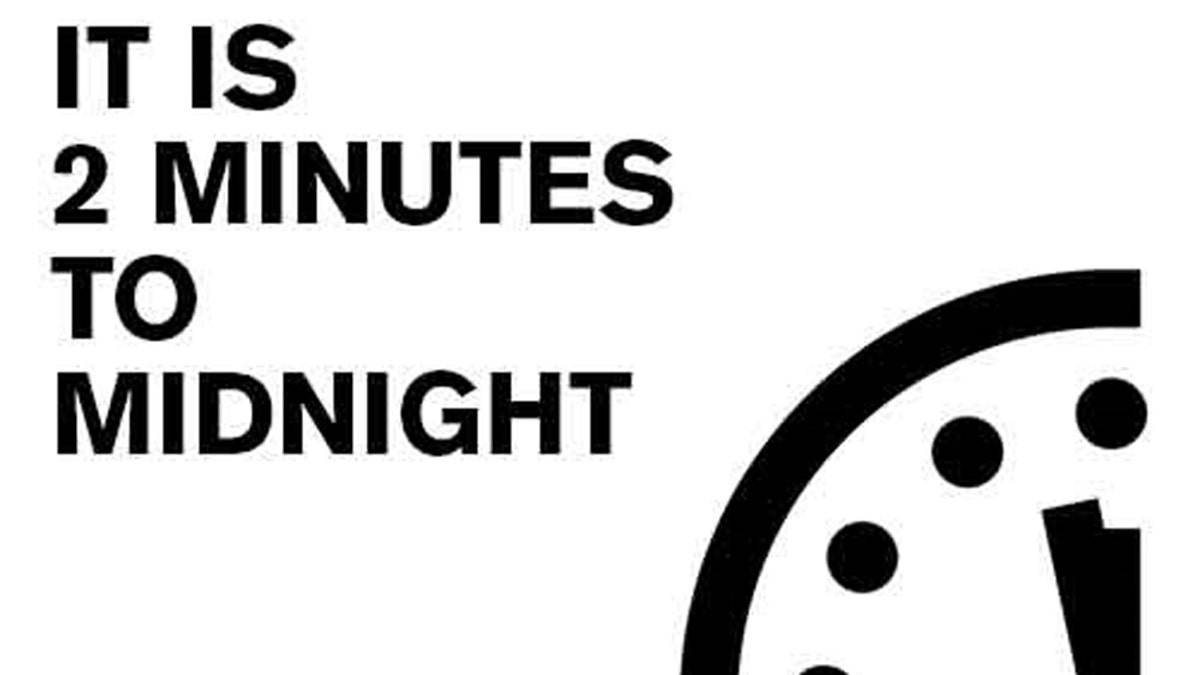The Doomsday Clock: What is it and why it sped up
The Bulletin of the Atomic Scientists has officially sped up the world’s Doomsday Clock, citing world leaders’ failure to deal with threats of nuclear war. Here’s a brief history of what the clock symbolizes and how it started.
The world has been just two minutes away from an “apocalypse” for the last two years – at least, that’s what the Doomsday Clock is saying.
At 10 a.m. ET on Jan. 23, the Bulletin of the Atomic Scientists, which updates the clock, will make their 2020 Doomsday Clock announcement.
The metaphorical clock skipped 30 seconds ahead two years ago to reach two minutes to midnight due to “reckless language” from world leaders, North Korea’s advancing nuclear weapons program, tensions between the U.S. and Russia, devastating natural disasters, among other reasons. The clock was kept at two minutes to midnight for last year's announcement. In a statement, the Bulletin of the Atomic Scientists, which updates the clock, cited "the devolving state of nuclear and climate security."
Two minutes to midnight is the closest the clock has been to doomsday in 65 years, at the height of the Cold War, according to the Bulletin.
In 2018, Fox News asked Rachel Bronson, the president and CEO of the Bulletin, to explain what the Doomsday Clock is, and why it has been creeping closer to midnight.
What is the Doomsday Clock?
The Doomsday Clock is a symbol that was created at the beginning of the Cold War in 1947 to represent the threat of nuclear weapons, which, the Bulletin says have the potential to destroy civilization as we know it.
Climate change, harmful chemical or biological agents and emerging technologies also play a major role in determining how much the clock has moved.
“We really track existential threats that are man-made,” Bronson told Fox News. “But the factors that have really moved the clock have always been nuclear from the beginning.”
Who determines how much the clock moves each year?
The Bulletin’s Science and Security Board (SASB), a group comprised of international experts in fields that focus on the climate, nuclear weapons and technology, meets twice a year "to discuss world events and reset the clock as necessary."
Do politics come into play?
Sure. The Bulletin follows politics and public policies throughout the year, but officials say the outcome shouldn't be interpreted as a political statement.
“We’ve moved it backward and forward pretty equally in Republican and Democratic administrations,” Bronson told Fox News in 2018. “That’s a criticism or a charge that’s been unfounded.”

The Bulletin of the Atomic Scientists moved the clock 30 seconds closer to midnight in 2018. (Bulletin of the Atomic Scientists)
Why was the clock moved 30 seconds closer to midnight in 2018?
"We were worried about the world’s nuclear rhetoric language, comments based on fake news and recklessness around issues that are so important," Bronson said. "Moving the clock 30 seconds conveyed the message they were trying to send: this doesn’t bode well."
President Trump was called out several times in the Bulletin's 2018 statement, specifically for his comments on North Korea.
The panel at the Bulletin also said 2017’s environmental disasters contributed to the moving of the clock – specifically the devastating wildfires in the U.S., powerful hurricanes, extreme heat waves and record-breaking shrinking Arctic ice caps.
Have you noticed any patterns in recent years?
The clock has been trending closer to midnight over the last 10 years.
It first started inching closer to doom in the early 2000s to signal U.S.-Russia relations were deteriorating, Bronson explained.
From 2015 to 2018, the clock has dropped from 3 minutes to 2 minutes.
How do you determine how much to move the clock?
There isn’t a specific formula SASB follows when determining how much to increase or decrease time.
“It’s really a judgment,” Bronson said. “They’re not back there calculating anything, though they do that frequently in their everyday jobs.”
Why does the Doomsday Clock exist?
The Doomsday Clock was created to spark conversation and give the public an idea of where the world is.
"It gets people more engaged and pressures the public to ask world leaders important questions," Bronson said. "There’s more awareness now; that's for sure."
The Bulletin also provides recommendations to improve the planet, which they hope leaders and citizens will consider.

